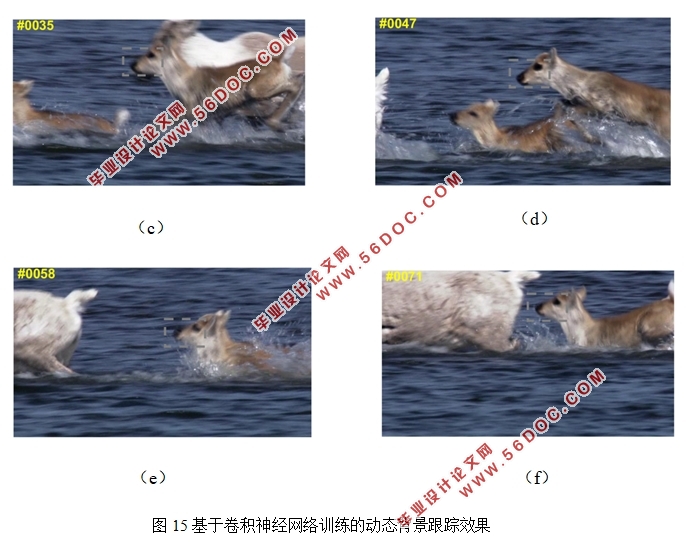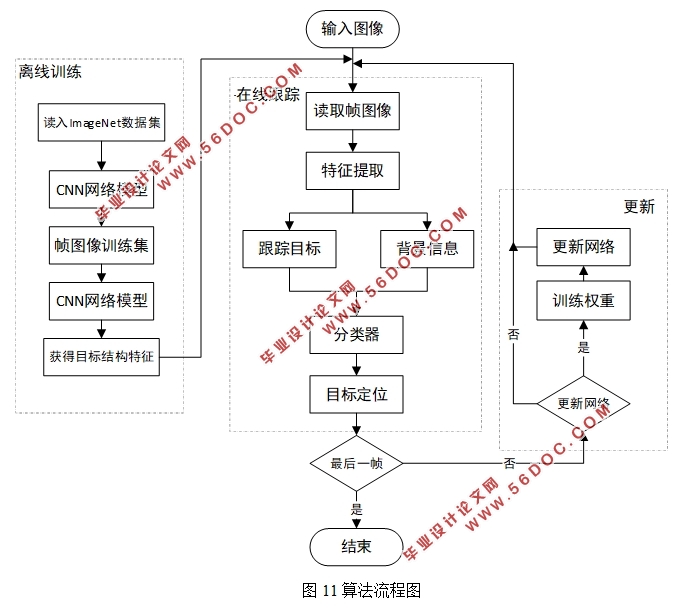基于卷积神经网络的目标追踪算法研究
来源:wenku7.com 资料编号:WK716534 资料等级:★★★★★ %E8%B5%84%E6%96%99%E7%BC%96%E5%8F%B7%EF%BC%9AWK716534
以下是资料介绍,如需要完整的请充值下载。
1.无需注册登录,支付后按照提示操作即可获取该资料.
2.资料以网页介绍的为准,下载后不会有水印.资料仅供学习参考之用. 密 保 惠 帮助
资料介绍
基于卷积神经网络的目标追踪算法研究(论文16000字)
摘要:本文以获得一个稳健且高精度的跟踪算法为研究课题,针对目标遮挡,光照变化,背景驳杂或相似等各种情况的发生,使用卷积神经网络(CNN)作为跟踪器的网络模型,采用“离线训练+在线微调”模式。采用了带有基准的视频序列集进行离线训练,在输出层使用Softmax分类器组成分类网络。在线初始化从输入帧提取正负样本,利用正负样本集训练Softmax分类器获得区分目标与背景的能力。更新采用长时更新与短时更新这两种不同的更新方式。长时更新是使用长期收集的正样本集进行定期更新,而负样本集更新都采用短时更新,解决了由于更新不及时发生的目标漂移问题。但由于卷积神经网络庞大的计算量,本算法仅能在帧图像的基础上做到目标跟踪,在高帧频的要求下就会暴露其劣势。
关键词:计算机视觉;卷积神经网络;目标跟踪;深度学习
Target trackingsystem based on convolutional neural network
Abstract:In this paper, a robust and high-precision tracking algorithm is selected as the research topic. For the occurrence of various conditions such as target occlusion, illumination change, background mismatch or similarity, a convolutional neural network (CNN) is selected as the network model of target trackers.using the ‘offline training + online fine-tuning’ mode. Video sequence set with reference is used for off-line training, Softmax classifier is used to form a classification network in output layer. Positive and negative samples are extracted from the input frame inonline initialization, and the Softmax classifier is trained by the positive and negative sample sets to obtain the ability to distinguish the target from the background. The update uses two different update methods.Long-term updates are periodically updated using a long-term collection of positive samples, while negative sample sets are updated with short-term updates,solved the problem of target drift caused by the update not happening in time. However, due to the huge computational complexity of the convolutional neural network, the algorithm can only achieve target tracking on the basis of frame images, and it will expose its disadvantages under the requirement of high fps.
Key words:Computer vision; convolutional neural network; target tracking; deep learning


目 录
1绪论 3
1.1课题研究的意义及背景 3
1.2国内外研究现状 3
1.2.1卷积神经网络的国内外研究现状 3
1.2.2存在的难点与问题以及发展趋势 5
1.3论文的章节安排 5
2目前常用的跟踪算法原理简述 6
2.1经典跟踪算法原理简述 6
2.1.1基于均值漂移的目标跟踪方法 6
2.1.2基于卡尔曼滤波的目标跟踪方法 8
2.2基于相关滤波的目标跟踪方法 9
3卷积神经网络(CNN)的结构简述 10
3.1卷积神经网络概述 10
3.2卷积神经网络基本结构 11
3.2.1图像输入层 11
3.2.2卷积层的工作原理 11
3.2.3激活函数 12
3.2.4池化层工作原理 14
3.2.5全连接层工作原理 14
3.2.6输出层:soft max分类器工作原理 15
4基于卷积神经网络(CNN)的目标跟踪算法原理 16
4.1 CNN的前向传播算法 16
4.2 CNN的反向传播算法 17
4.3卷积网络训练 18
4.4基于CNN的目标跟踪算法流程 18
5基于CNN的目标跟踪算法仿真与分析 20
5.1目标跟踪实验环境 20
5.2目标跟踪算法性能评估方法 20
5.3实验结果与分析 21
5.3.1 静态背景下的CNN的目标跟踪 23
5.3.2 动态背景下的基于CNN的目标跟踪 24
5.3.3 动态背景下的含有复杂光影变化的目标跟踪 25
6总结与展望 27
参考文献 28
致谢 30
|





